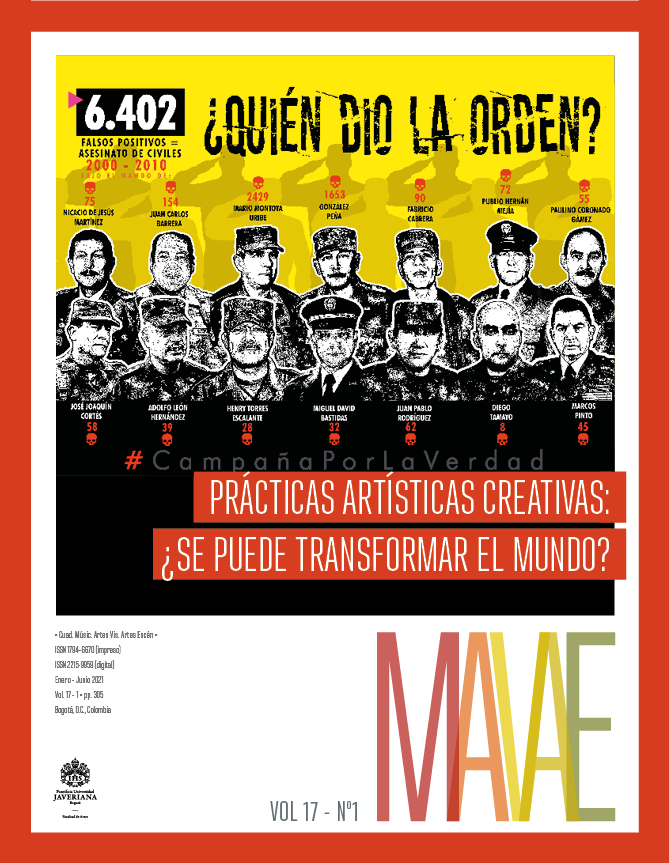Abstract
We live in a time in which the conceptions of citizenship, the State, the market, and representation have fallen into a crisis. Consequently, we can observe how the binding link between the people and their governments has been broken. The despair of not being able to discern a dignified future has exhorted a social uprising in which all kinds of manifestations can be found, these mainly in urban spaces, at times articulate to artistic and cultural experiences, which unite the protests in decentralized ways; not only emerging as demonstrations of disenchantment, frustration, and systemic collapse, nevertheless, in their becoming, they propose new paths of social construction. The article reflects on the operation of artistic and cultural practices and devices that have emerged in the current situation of the protests, as well as on the transformative political dimension involved in the analyzed experiences. For this purpose, the paper is divided into three parts: questions, answers, and considerations. The first one analyzes questions raised in the actions of the protests; the second one evaluates responses generated from institutional and non-institutional fields of art, for which the studied examples are categorized in their capacity to re-formulate urgencies, alter paradigms, and metabolize their contexts; and the third one raises possibilities on how artistic and cultural experiences would have the capacity not only to visualize but also to promote the emergence of new communitarian ecologies, new forms of decentralized common reorganizations, by virtue of the encouragement around the cultivation of egalitarian communities.
Benjamin, Walter. 1968. Illuminations. Traducido por Harry Zohn. Nueva York: Schocken Books a division of Random House.
Bookchin, Murray. 1982. The Ecology of Freedom: The Emergence and Dissolution of Hierarchy. Palo Alto: Cheshire Books.
Bookchin, Murray. 2007. Social Ecology and Communalism. Oakland: AK Press.
Cefaï, Daniel. 2002. L’heritage du pragmatism: Conflits d’urbanité et épreuves de civisme. París: L’Aubé.
Chakrabarty, Dipesh. 2000. Provincializing Europe: Postcolonial Thought and Historical Difference. Princeton: Princeton University Press.
Delgado, Manuel. 2011. El espacio público como ideología. Madrid: Catarata.
El CEP presenta. (2019). “Manuel Castells en el CEP”. https://www.youtube.com/watch?v=h97emCUyMf0.
Museo Nacional. 2021. “Fragmentos, espacio de arte y memoria”. http://www.museonacional.gov.co/micrositios1/Fragmentos/index.html#section-about.
Groys, Boris. 2009. “Arte y poder”. Conferencia pronunciada en The Drawing Centre.
Harvey, David. 2008. “The Right to the City”. The New Left Review. https://newleftreview.org/issues/ii53/articles/david-harvey-the-right-to-the-city
Lai, Ten‐Herng. 2020. “Political Vandalism as Counter-Speech: A Defense of Defacing and Destroying Tainted Monuments”. European Journal of Philosophy 28, n.º 3: 602-616.
https://doi.org/10.1111/ejop.12573.
Sholette, Gregory. 2011. Dark Matter: Art and Politics in the Age of Enterprise Culture. Nueva York: Pluto Press.
Schulz, Johannes. 2019. “Must Rhodes Fall? The Significance of Commemoration in the Struggle for Relations of Respect”. Journal of Political Philosophy 27, n.º 2: 166-186. https://doi.org/10.1111/
jopp.12176.
Smith, William. 2011. “Civil Disobedience and the Public Sphere”. Journal of Political Philosophy 19, n.º 2: 145-166. https://doi.org/10.1111/j.1467-9760.2010.00365.x.
Sunstein, Cass R. “On the Expressive Function of Law”. University of Pennsylvania Law Review 144, n.º 5 (1996): 2021-2053. https://doi.org/10.2307/3312647.

This work is licensed under a Creative Commons Attribution 4.0 International License.
Copyright (c) 2021 Camilo Escobar Pazos


